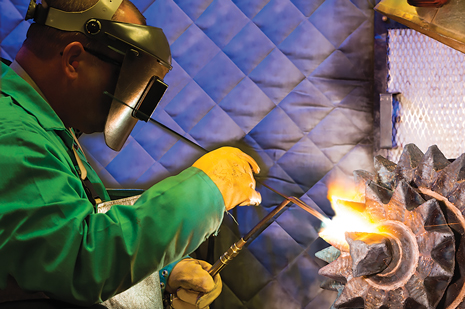 |
| A Baker Hughes employee adds hardfacing to a tricone roller cone bit. Picture courtesy of Baker Hughes. |
|
Drill bits are highly expensive, precisely constructed products, and the fewer of them that are required for a well, the better the margins. The easy oil was produced long ago, and operators find themselves caught between sagging oil prices and more difficult formations in a continuous effort to make well drilling economical. Bit designers have stepped up to the challenge.
Manufacturers have focused on the science of materials, seeking to increase wear resistance without sacrificing impact strength. Improvements in steel, tungsten carbide and polycrystalline diamond have all continued at a steady pace. With vibration a major factor in bit wear, the science has also worked steadily to improve stability and control. Computer-aided design has come increasingly into play, as the ability to customize a bit to the formation becomes more practical.
Unconventional plays continue to grow as a larger share of drilling targets, meaning more and longer laterals, with a greater demand for steerability. While roller-cone bits are still valued for their high ROPs, PDC bits and hybrids have seen the most utility, and that’s where the greatest efforts have been made.
DIRECTIONAL HYBRID DRILL BITS
The Baker Hughes Kymera FSR directional hybrid drill bit, Fig. 1, was designed to deliver fast, smooth and reliable performance while drilling curve sections in challenging carbonate formations. The Kymera FSR bit drills to total depth (TD) with fewer bits, less nonproductive time (NPT), and better overall drilling economics.
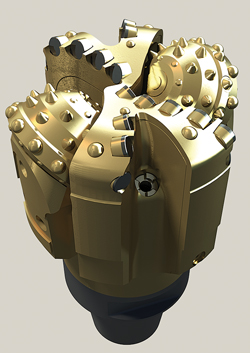 |
| Fig. 1. The sharp tungsten carbide insert teeth of the Kymera FSR’s roller cones cut and crush hard rock, while the PDC cutters sweep away the remaining cuttings. |
|
Drilling the curve through carbonates typically takes two or more bits when using individual PDC or tricone roller cone bits. While PDC bits drill quickly, they create reactive torque that can send the bottomhole assembly off its intended trajectory. That excessive vibration can also influence downhole tool failure, increasing the odds of additional trips, parts repair and NPT. Roller cone bits create less vibration for better directional control, but drill more slowly.
By focusing on the best attributes from both the tricone and PDC bit designs, the Kymera FSR bit drills more consistently for precise steerability. The sharper tungsten carbide insert teeth of the roller cones cut and crush hard rock, while the PDC cutters sweep away the remaining rock and effectively clean the borehole. The balance of the two cutting structures provides better toolface control and cutter protection, keeping torque in check and eliminating excess energy to the drillstring.
With energy focused where it needs to be in a smooth borehole, tools in the drillstring can be more effective, and directional drillers can spend less time correcting trajectory. In the case of the new directional Kymera bit, with its increased efficiency, the result is a consistent rate of penetration (ROP), exceeding and sometimes doubling that of the fastest PDC and tricone bits. On a majority of curve runs, it only takes one Kymera bit to reach TD.
In field tests in the Permian, Eagle Ford and Williston basins, 51 runs of the Kymera FSR bit showed an 80% average increase in ROP over the offset average, and an 82% success rate in getting to TD with just one bit, reducing bit trips, NPT and total drilling costs in the curve.
SELF-STABILIZING PDC BITS
Drill Master Inc. is offering a new self-stabilized PDC bit called StaBit, Fig. 2. The unique stabilizing features of the StaBit eliminate vibration and “bit walk”. The stability of the bit helps maintain sharpness and significantly increases durability. The anti-walk capability eliminates deviation and optimizes wellbore quality, and bit dulling and tripping can be virtually eliminated. StaBit is designed for vertical applications with rotary or positive displacement motors, where deviation must be controlled. It exhibits superior performance in extremely hard formations with moderate to severe formation changes, and will drill long sections. It is also capable of drilling shale and limestone sections with intermittent sandstone stringers, fractures or faults at pressures of 15,000-40,000 psi.
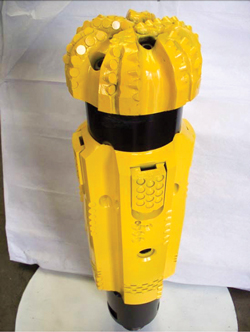 |
| Fig. 2. Stabilizing features of the StaBit reduce vibration and bit walk. |
|
StaBit has reinforced PDC gauge protection and back reaming cutters. Hard formation cutters offer increased impact and abrasion resistance, along with impact-arresting impregnated studs. Built-in stabilizers prevent cutter breakage and extend wear life. The bit was developed with computer-aided design for fast penetration rates, longer bit life and straight drilling.
SOFTWARE TO OPTIMIZE DESIGN
Halliburton’s Drill Bits and Services business-line has advanced the science of bit design optimization with the development of a new single cutter force model and bit model that more accurately predicts operational efficiency. At the core of the design is Halliburton’s proprietary Design at the Customer Interface (DatCI) process.
Using the upgraded IBitS software, developers are able to incorporate solutions and produce new drill bits geared toward specific formation properties with the goal of reducing bit deterioration and increasing efficiency, Fig. 3.
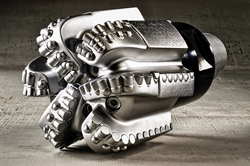 |
| Fig. 3. IBitS software enables developers to produce new drill bits geared toward specific formation properties. |
|
The single-cutter force model differs from present cutting-area-based models, which do not account for cutter shape and location. Depending on these factors, the actual cutting forces will vary, resulting in reduced bit-rock interaction. Additionally, these current models do not account for cutting fragments, which must be removed, affecting bit performance.
The company addresses these shortcomings with a process in which three-dimensional rock chips are created in front of the cutting face. These chips are removed from the simulated bottom of the well bore and continuously updated at each step.
Using the new cutter force model and integrating the chip model into the bit-rock interaction model, IBitS software can better predict the sensitivity of drilling efficiency to changes in design variables, particularly global variables like cutter layout, making true design optimization possible.
MATERIALS TECHNOLOGY IMPROVES CUTTERs
In recent years, Kingdream has focused its research for roller cone drill bits on the material technology of the cutters, specifically the development of a uniform structure for cemented carbide. Optimizing the sintering process based on traditional material technology, the mixed crystalline structure of the cemented carbide can be made more uniform, significantly increasing the cutters’ performance, particularly abrasion resistance, bending strength, impact toughness and fracture resistance.
To improve the kick-off ability of PDC bits in horizontal and directional wells, ultra-short one-piece steel body PDC bits have been developed, Fig. 4. They employ PDC-enhanced gauge protection, so that the length of the bit shank can be reduced, preventing failure ahead of the shoulder and gauge section during kick-off, and extending the life of the bit.
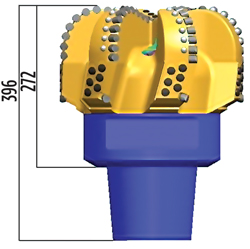 |
| Fig. 4. Ultra-short one-piece steel body PDC bits improve kick-off ability. |
|
Kingdream has also developed new smooth-cutting PDC bits that employee large spiral blades to increase stability of the bit, Fig. 5. DOC (depth of cut) limiting penetration technology is applied, so that it can control ROP, improve stability and extend service life of bits. The exposure height of trimmer cutters are controlled by LMM (lateral movement mitigator) technology, in order to reduce transverse vibration of bits, prevent impact damage and increase the bit’s stability.
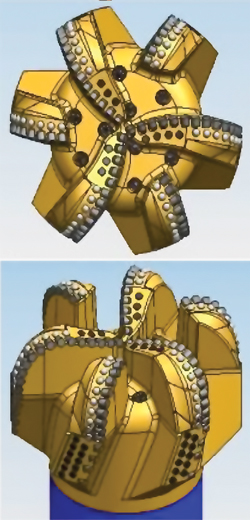 |
| Fig. 5. Smooth-cutting PDC bits with large spiral blades increase bit stability. |
|
CONICAL BIT DESIGN BOOSTS ROP
Using applied science and integrated design software, engineers at Smith Bits, a Schlumberger company, have developed and tested a unique bit design with significant advantages, Fig. 6. Starting with a proven design SHARC MDSi616 PDC bit, finite element analysis techniques were used to determine stress patterns, high wear areas and factors limiting performance. Then, the IDEAS integrated drill bit design platform was used to model and simulate performance factors for optimization.
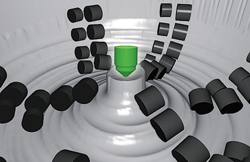 |
| Fig. 6. The conical design of the Stinger diamond element places maximum load on a single point of rock. |
|
The new design had to fail rock more efficiently at the bit’s center, eliminate cored-out dull condition to extend bit life, and drill more efficiently over a wider range of formations and well trajectories
A unique design evolved with an innovative conical cutting element placed at the bit’s center. Stinger conical diamond element has an ultra-thick diamond layer for extended wear. Simulations confirmed that the PDC cutters nearest the bit’s center had the highest load, but the lowest rotational velocity. As a result, rock removal by the center cutters was less efficient, especially in hard formations. In addition, formation changes in transition zone drilling could cause wide variations in depth-of-cut, leading to high torsional vibration with reduced ROP and cutter damage.
Because the conical design of the Stinger conical diamond element places maximum load on a single point of rock, the rock fractures and is crushed. Since the element is located at the center of the bit, stability is enhanced and vibration is minimized. Most importantly, ROP is dramatically improved, along with bit durability. Cuttings produced by the Stinger element are larger than those typically produced by PDC bits, providing valuable samples big enough for geological analysis. Bit nozzle performance was modeled and optimized for the new design to enhance cleaning ability.
Another benefit offered by the Stinger conical diamond element design is extended bit life. Operators can reach TD with fewer bit trips due to wear, and because the versatile design improves ROP in vertical, build and lateral borehole sections, no switch-outs are required.
Before taking the new bit to the field, extensive simulation and drilling lab measurements were made. The objective of the advanced testing was to be able to measure increased bit stability and resultant borehole quality. The additional quantity of rock removed over a given section was compared with standard MDiS616 PDC bits as well as comparable competitive bits, and large cuttings usable for geological analysis were measured.
To ensure that bit life issues were adequately addressed, further testing quantified bit durability. Three factors were examined. In every test, the Stinger elements excelled, with 20% better wear resistance, 50% higher impact strength and 50% improved diamond thickness compared with standard PDC bits.
Bit utilizes new conical diamond element. Employing the new Stinger element, Smith Bits has introduced the StingBlade bit, Fig. 7. These bits increase run length and ROP while delivering improved steering response.
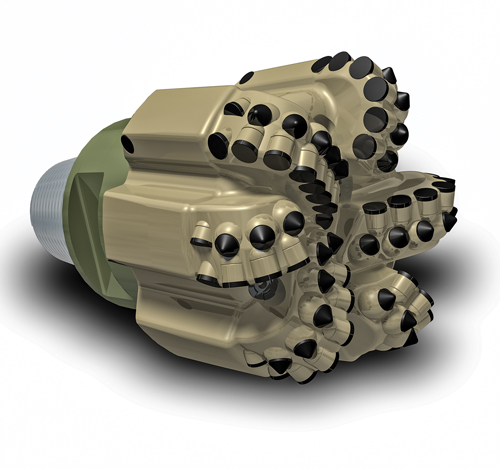 |
| Fig. 7. The new conical diamond elements, optimally placed across the bit face, improve impact and wear resistance, and induce high point loading on the formation, enabling higher sustained ROP. |
|
StingBlade bits use the new conical diamond elements optimally placed across the bit face. The conical shape of Stinger elements, with improved impact and wear resistance, induce high point loading on the formation, enabling increased run lengths and higher sustained ROP. In directional applications, the new drill bits cut with lower torque than conventional cylindrical cutters and achieve higher build rates with less toolface variation.
The bits have been successfully tested in more than 300 wells worldwide, both onshore and offshore, in conventional and unconventional applications in North, Central and South America, the North Sea and Europe, Africa, the Middle East, Russia, Southeast Asia and Australia. To date, more than 686,000 ft have been drilled.
In a field trial conducted in the offshore Browse basin in Australia, an operator used a StingBlade bit to drill a 12¼-in vertical section through a formation known to cause premature impact damage to conventional PDC bits. The drill bit exceeded the planned footage interval, increasing interval length by 97% and ROP by 57%.
In an onshore field trial conducted in South Texas, two curves were drilled to compare the steerability to a conventional PDC bit. Under identical conditions, the StingBlade bit achieved 23% higher build rates with less torque and toolface angle variation, reducing corrections required by directional drillers.
PDC BIT WITH MICRO-CORING ABILITY
Tercel Oilfield Products has released its new MicroCORE cutting system, Fig. 8. Developed in collaboration with Total, the system redistributes high-energy consumption from the center of the drill bit to the more efficient areas of the cutting structure. Replacing the inefficient compression failure mechanism in the center of a traditional cutting structure, MicroCORE delivers more energy to the cutters, higher ROP and better quality wellbores.
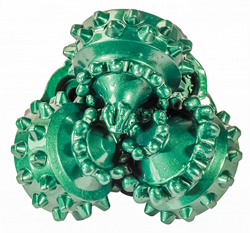 |
| Fig. 8. The MicroCORE system recovers core fragments from the well that are undisturbed by the shearing action of the cutters, providing excellent samples for core analysis onsite or in the lab. |
|
Conventional bits place the first cutter in the center of the structure, inducing high compression, indentation and minimum shearing of the rock, consuming valuable energy in an inefficient cutting process. In addition, because the first cutter is in the center and the second is typically about half a radius apart to facilitate smooth coverage over the two to three blades that reach the center, the first cutter takes a larger bite than the cutters on the cone/nose/shoulder. While not a big problem for the cutter, in terms of imbalance force calculation this is much more problematic, as the high load significantly influences the imbalance force and its direction. As the bit goes through heterogeneous rocks, these forces fluctuate dramatically and induce variation in the imbalance forces, leading to vibration, excess energy consumption and damaging cutters.
The new cutting system focuses on delivering maximum energy to the cutters across the most efficient portions of the cutting structure. The MicroCORE structure eliminates the inefficient compression failure mechanism in the center of a traditional cutting structure by removing the center cutters. Intensive testing conducted internally and in several laboratories and universities have shown that the power saved on the central structure is redistributed to the external cutters. The external cutters have a more efficient cutting mechanism and this increased ROP.
The MicroCORE cutting system cuts around the center of the hole creating a small core, applies a simple lateral force to sever it, and sends the core to the surface with the regular cuttings. The MicroCORE cutting system can have several cutters around the center core, and can be designed with much smoother force distribution to optimize the stability and cutting efficiency for improved performance.
The MicroCORE cutting system has delivered 778 fph in South Texas, 103 fph for 98 hours and drilled over 10,159 ft in a single run in Wyoming, as well as returning in consistently better dull condition than traditional PDC drill bit cutting structures.
FRAC PLUG DRILLOUT
The growing number of frac plugs in multizone completions has placed increased emphasis on the performance of bits used in coiled tubing drillout operations. The composition of these plugs—hard external components and relatively soft internal material—presents unique challenges to bit life.
The Varel SlipStream RC Pro completions bit, Fig. 9, is a hybrid design developed specifically for the task, with an outer cutting edge of tungsten carbide inserts (TCI) and an inner steel tooth cutting structure. The design has achieved significant durability and improved ROP. In a 57-well study in the Eagle Ford shale, the hybrid bit drilled frac plugs 13.6% faster than standard tooth bits, and averaged 3.3 more plugs per use.
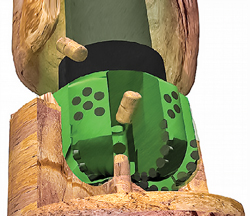 |
| Fig. 9. Combining both steel tooth and tungsten carbide inserts provided a way to drill out the hard and soft frac plug materials without sustaining bit damage. |
|
The bit is the result of collaborative research between the operator and plug manufacturers to identify the various materials used to build frac plugs and engineer the best cutting structure for the task. The materials ranged from very hard materials such as case-hardened slips with ceramic or titanium inserts, to composite, plastic and rubber materials. The common design element was that the hard parts were on the outside and soft parts were in the middle.
Using steel tooth bits to drill this heterogeneous material had two negative results—wear to the outer cutting structure and the large cuttings size that were produced. When the tooth size was reduced, the cuttings were smaller. However, damage to the outer row was unabated. The bits were clearly drilling the center of the plug but not the hard outer materials.
The hybrid concept gained strength when an insert bit was used, with the opposite results—the inner cutters were damaged and the outer row was not.
Combining the two cutting structures—steel tooth and TCI—provided a way to effectively drill out the hard and soft frac plug materials without sustaining run-limiting damage to the bit. The SlipStream bit features fully capped premium hardmetal teeth that are closely spaced to generate small cuttings. Medium extension chisel inserts on the outer cone rows quickly drill the plug’s outer metal components. The bit’s reduced cone offset provides the needed chipping and crushing drilling action.
Applications in the Gulf Coast region have drilled more than 20 plugs per well while achieving drillout times as fast as 5 min. per plug. In doing so, the cutting structures have consistently displayed only slight wear and minimal insert chipping. The bits have further improved efficiency by reducing stalling of the small motors typically used in these applications.
Success of the hybrid design is significantly improving bit performance and, as a result, improving the efficiency of multi zone hydraulic fracturing operations. 
|












